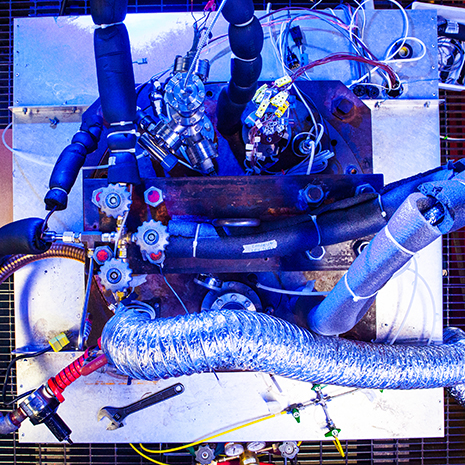
FAYETTEVILLE, Ark. – Research at the University of Arkansas Center for Space and Planetary Sciences will make it possible for scientists to work with more accurate computer models of methane evaporation on Saturn’s moon, Titan. To obtain the new data, researchers built a special chamber that mimics the surface conditions on Titan.
“We are the first ones to really measure the dynamics of transfer between the liquid methane and the atmosphere under Titan conditions,” said Vincent Chevrier, a research assistant professor at the center, and principal investigator on the project.
“Since Titan is the only other planetary body that has liquids on its surface, it’s important to understand their stability,” said Adrienn Lupsay-Kuti. “The experiments we conducted help us understand the interactions between the surface and the atmosphere, and thus the hydrological cycle on Titan.”
Luspay-Kuti, a doctoral candidate in the space and planetary program, led the research.
When dealing with planetary bodies, there are three main ways of obtaining information: spacecraft data, computer modeling and experiments. Spacecraft data are useful but in the case of Saturn and Titan, are only able to give a small snapshot due to Saturn’s long year and Titan’s opaque atmosphere. Computer models can be run that cover many years, but they rely on educated assumptions in regards to some of the parameters.
“The missing link between spacecraft data and models are the actual experiments that we are able to do. By creating conditions similar to Titan’s surface, we can, in fact, measure these parameters in the lab. That will provide strong constraints on models and give a whole new insight into how these processes work,” Luspay-Kuti said.
Obtaining the data was not as simple as opening a bottle and watching the liquids disappear. A special chamber had to be built that could mimic the moon’s conditions. A video of the experiments can be seen here.
“We built a Titan simulation chamber so we are able to simulate the surface conditions of Titan. We condense the hydrocarbons, which are gaseous on Earth, and monitor the evaporation of the liquids,” Lupsay-Kuti said.
In order to properly simulate the moon’s conditions, the temperature of the chamber had to be cooled to minus 180 degrees Celsius (minus 292 degrees Fahrenheit), and the pressure had to be raised to 1.5 bars, 50 percent higher than the atmospheric pressure on Earth. The temperature and pressure were maintained by pumping nitrogen through the system. Nitrogen is the primary constituent in Titan’s atmosphere. With the surface conditions intact, the researchers condensed methane and observed the evaporation of the compound. What they found changes the way Titan atmospheric computer models should be run.
In the areas close to the equator on Titan, storms and transient lakes have been observed. These, scientists believe, are composed almost entirely of methane. In the higher latitudes, where the liquid bodies are more stable, researchers believe the lakes and seas are mostly composed of the more complex compound ethane.
Previous computer models assumed evaporation occurred due to incoming energy heating the methane. The University of Arkansas team’s experiments point to additional drivers: diffusion and buoyancy. With diffusion, evaporation occurs because the atmosphere above the liquid has a small concentration of methane. The difference in the methane concentrations between the liquid surface and the atmosphere causes the methane to evaporate. Once the atmosphere is fully saturated with methane, the diffusion-evaporation stops. Buoyancy-driven evaporation occurs because Titan’s atmosphere is mostly made up of molecular nitrogen, which is heavier than methane. As a result, methane rises through nitrogen. High in the atmosphere, methane condenses, forms clouds and precipitates, much like water does on Earth. The experimental data will allow scientists to work with more accurate models.
“The good thing is now we have one of the most precise values of the evaporation of methane. We are able to determine that you could, indeed, over the timescale of a storm accumulate enough liquid methane to form transient ponds and lakes in the equatorial regions,” Chevrier said.
Working with Lupsay-Kuti and Chevrier on the research were Felix Wasiak who earned his doctorate and now works for Northrop Grumman; Larry Roe, associate professor of mechanical engineering and space center faculty member; Dimuth Welivitiya, a former space and planetary sciences graduate student who now works at the Arthur C. Clarke Institute in Sri Lanka; Thomas Cornet of the Laboratoire de Planetologie et Geodynamique de Nantes, France; graduate student Sandeep Singh; and Edgard Rivera-Valentin, a graduate of the space and planetary sciences program and now a postdoctoral research associate of geological sciences at Brown University.
The NASA-funded research was published in the Dec. 14 issue of Geophysical Research Letters. The experimental results, along with data obtained since publication, were presented at the Lunar and Planetary Science Conference on March 19.
The Lunar and Planetary Science Conference is the premier conference for the field each year. Twenty students and faculty from the Arkansas Space and Planetary Sciences presented 18 posters and four oral presentations at the conference.
Topics
Contacts
Vincent Chevrier, research assistant professor
Space and Planetary Sciences
479-575-2183, vchevrie@uark.edu
Adrienn Lupsay-Kuti, graduate student
Space and Planetary Sciences
479-575-3394, alupsayk@uark.edu
William T. Bryan, intern
University Relations
479-575-5555, wxb004@uark.edu